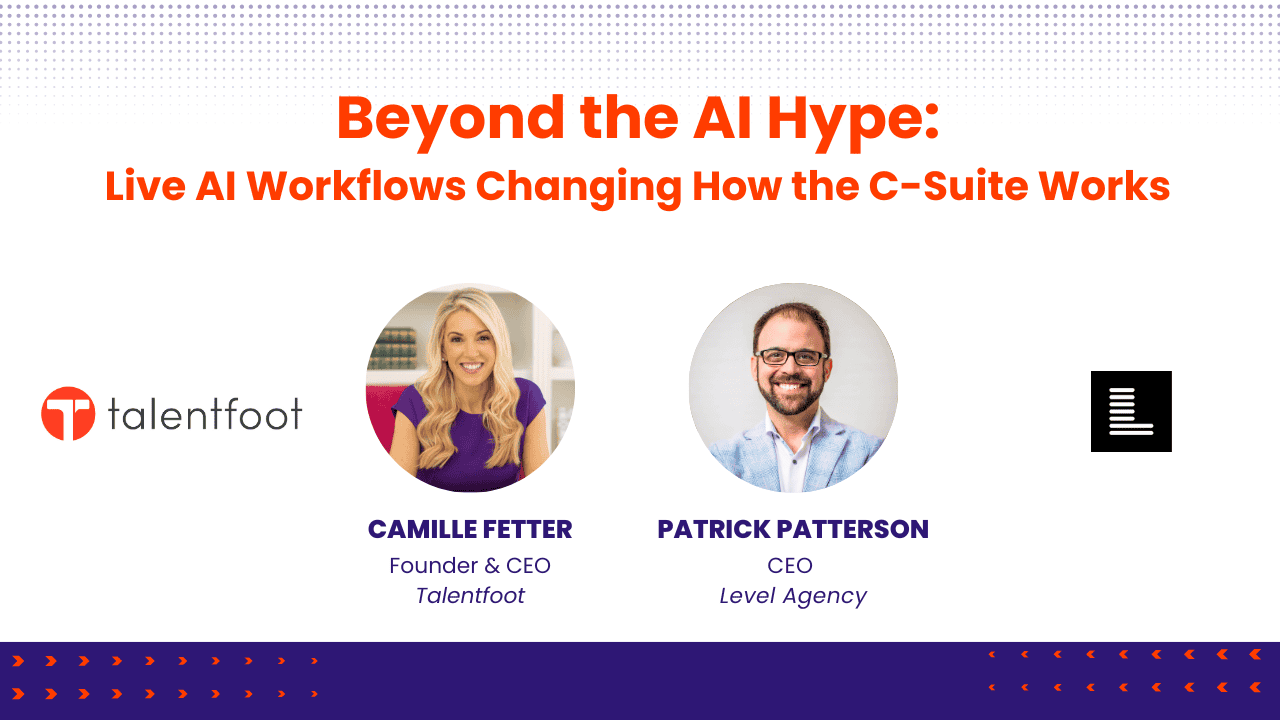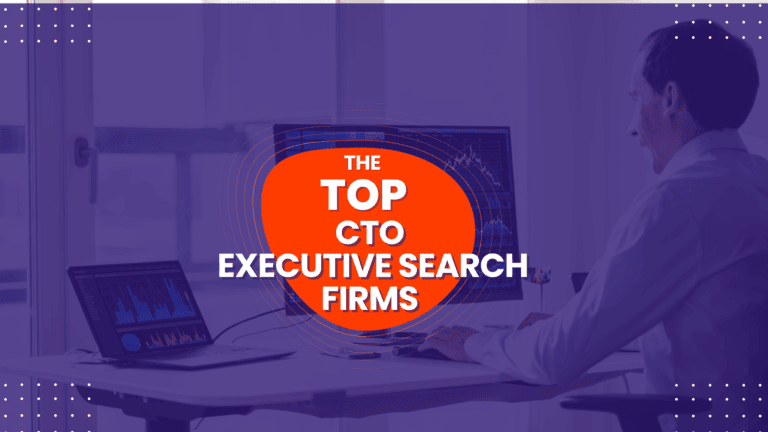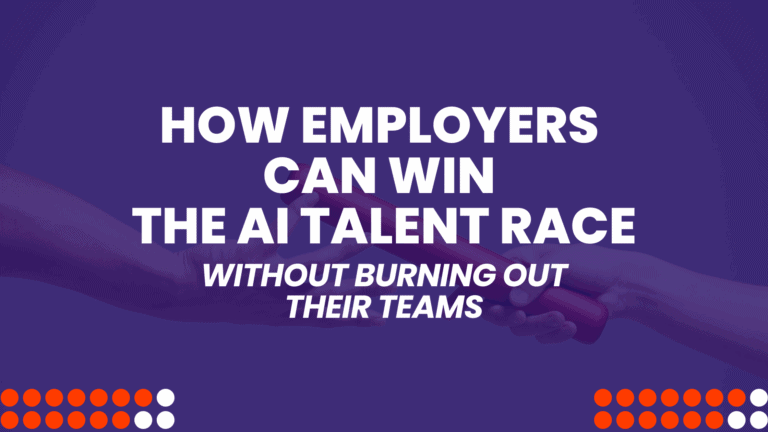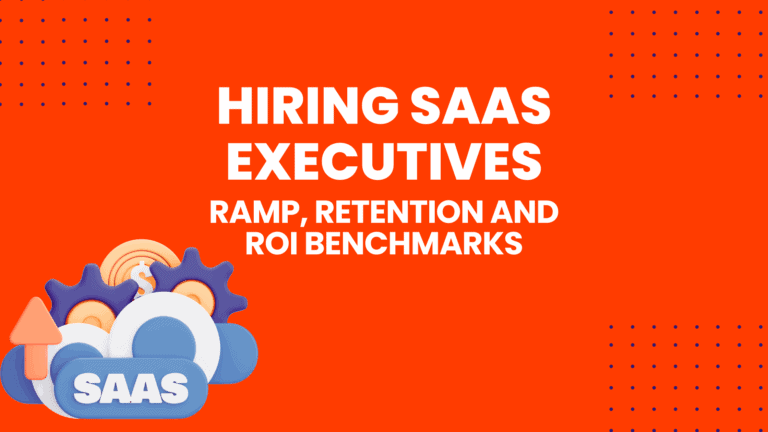For most executives, AI is no longer just an emerging technology. It’s the critical factor shaping competitive advantage, redefining efficiency, and influencing strategic direction. Yet, despite its prominence, many senior leaders find themselves navigating uncertainty. They’re confronted with a daily barrage of AI trends, tools, and promises, wondering how much is hype and how much can genuinely drive their businesses forward.
This tension was precisely why Talentfoot hosted part III of our AI C-Suite Series – “Beyond The AI Hype: Live AI Workflows Changing How the C-Suite Works.” Featuring Patrick Patterson, CEO of Level Agency, and facilitated by Talentfoot Founder and CEO Camille Fetter, this insightful discussion provided actionable strategies for leaders determined to make AI more than a theoretical exercise. The conversation shifted the narrative from AI’s potential to its measurable impact, highlighting workflows currently transforming executive productivity, decision-making, and competitive positioning.
Below, you’ll find the full webinar record along with a recap of the key insights from the webinar, challenging you to reconsider how effectively your organization is currently integrating AI. You can download Patrick’s slide deck, here.
Recap & Key Takeaways
1. Rethinking AI: From Strategy to Necessity
Patrick Patterson opened the webinar with a provocative stance, arguing that executives often make the mistake of treating AI as an isolated strategy. Instead, he urged C-suite leaders to view AI as an integral, indispensable element woven throughout every strategic priority.
“You don’t have an electricity strategy or an internet strategy. AI should similarly become deeply embedded in every facet of your organization.”
— Patrick Patterson, CEO, Level Agency
This approach compels leaders to question: Are you embedding AI at the core of your strategic processes, or merely treating it as a temporary initiative?
2. AI Adoption is a Leadership Challenge, Not a Tech Issue
Building on this critical reframing, Camille Fetter highlighted that successful AI adoption hinges far less on technology and far more on people. Executives who excel at managing change, communicating vision, and empowering teams are positioned to succeed with AI. Patterson further underscored this point by noting that typically 20 to 30 percent of employees resist AI initiatives. Leaders must be prepared to manage that resistance actively through thoughtful education, clear communication, and demonstrable quick wins.
This prompts a critical reflection: Is your leadership team truly prepared to handle the cultural shifts AI demands?
3. Start Small, Prove Value, Then Scale Rapidly
Patterson offered concrete advice for executives struggling to identify how best to begin their AI journey. Rather than launching overly ambitious projects, he recommended focusing initially on smaller experiments that quickly demonstrate clear value.
Level Agency’s real-world examples reinforced this point clearly:
-
Accelerated Client Onboarding:
An AI-supported workflow that reduces client onboarding from several days to mere hours, streamlining tasks, automating data collection, and generating actionable insights almost instantly. -
Personalized Email Communication:
Automated drafting of personalized communications leveraging AI to pull publicly available information, ensuring outreach is more relevant, impactful, and engaging. -
Daily Executive Briefings:
AI-generated morning briefings that aggregate calendar data, meeting contexts, and priority items, helping leaders start each day strategically informed and prepared.
Reflect for a moment: Could your organization benefit from applying these straightforward AI workflows today?
4. Practical AI Workflows Leaders Should Implement Now
To ground theory in reality, Patterson detailed additional examples executives can adopt without significant technical barriers:
Personalized Sales and Marketing Outreach
By pairing CRM data with AI tools, companies can create customized messaging for prospects that vastly outperform generic campaigns.
Custom AI “Board of Directors”
Executives can build AI assistants mirroring board member expertise, ensuring presentations and communications are rigorously tested before high-stakes meetings.
“I use AI trained on my board’s preferences to refine board decks. It’s like having real-time access to expert advisors at any moment.”
— Patrick Patterson
Knowledge Management Navigator
Custom GPT tools can serve as central repositories for crucial company information, allowing executives rapid, intuitive access to critical insights without manual searches.
These examples compel every executive to consider: How much untapped productivity remains hidden within our current workflows?
5. Ensuring AI Initiatives Actually Deliver Results
Adopting AI is one challenge, ensuring it delivers sustained value is another. Patterson outlined several key recommendations for executives committed to successful implementation:
-
Explicitly align AI use cases with strategic goals, not just technological possibilities.
-
Regularly evaluate AI models for their unique strengths: creative, analytical, or rapid response capabilities.
-
Promote a culture where experimentation is encouraged and failure is quickly turned into iterative learning.
Have you clearly outlined these principles in your approach to AI?
6. Essential Insights and Executive Perspectives
Throughout the discussion, Patrick reinforced the critical nature of why the time for AI adoption is now.
-
“Every AI tool you use today is the worst version it will ever be. It will only improve from here.”
-
“The cost of testing an idea has essentially dropped to zero with AI. What does that mean for your innovation strategy?”
-
“Organizations fully embedding AI into operational DNA will thrive. Those hesitating risk becoming obsolete.”
These statements urge leaders to confront an uncomfortable but essential truth: Is your organization positioned for AI-enabled innovation, or will hesitation limit your future?
7. Immediate Next Steps: What C-Suite Leaders Must Do Now
To transition effectively from understanding to action, Patterson offered a clear set of immediate steps for executives:
-
Evaluate and address your team’s current AI literacy.
-
Identify and execute at least one practical AI-driven workflow within the next month.
-
Integrate AI competence into your recruitment and leadership evaluation criteria.
-
Commit to flexible technology strategies capable of rapid evolution.
“The best time to start implementing AI was yesterday. The second-best time is today.”
— Patrick Patterson
Is Your Team Equipped with the AI Talent Needed to Stay Ahead?
The pace of AI innovation isn’t slowing down, and neither are your competitors. The question every executive team should be asking right now isn’t just how to use AI, but who will lead those efforts internally. Do you have the talent in place to operationalize AI across your organization, drive adoption, and unlock ROI?
At Talentfoot, we specialize in helping companies hire proven AI, data, and digital transformation leaders who can future-proof your business and turn ambition into execution.
If you’re unsure whether your team has the talent needed to stay ahead, or if you’re already falling behind, contact us today. Let’s build a team that’s not just AI-aware, but AI-powered.
Get in touch with us to hire your next AI-ready leader.




